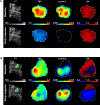Monitoring early response to chemoradiotherapy with 18F-FMISO dynamic PET in head and neck cancer
- PMID: 28540417
- PMCID: PMC6563902
- DOI: 10.1007/s00259-017-3720-6
Monitoring early response to chemoradiotherapy with 18F-FMISO dynamic PET in head and neck cancer
Abstract
Purpose: There is growing recognition that biologic features of the tumor microenvironment affect the response to cancer therapies and the outcome of cancer patients. In head and neck cancer (HNC) one such feature is hypoxia. We investigated the utility of 18F-fluoromisonidazole (FMISO) dynamic positron emission tomography (dPET) for monitoring the early microenvironmental response to chemoradiotherapy in HNC.
Experimental design: Seventy-two HNC patients underwent FMISO dPET scans in a customized immobilization mask (0-30 min dynamic acquisition, followed by 10 min static acquisitions starting at ∼95 min and ∼160 min post-injection) at baseline and early into treatment where patients have already received one cycle of chemotherapy and anywhere from five to ten fractions of 2 Gy per fraction radiation therapy. Voxelwise pharmacokinetic modeling was conducted using an irreversible one-plasma two-tissue compartment model to calculate surrogate biomarkers of tumor hypoxia (k 3 and Tumor-to-Blood Ratio (TBR)), perfusion (K 1 ) and FMISO distribution volume (DV). Additionally, Tumor-to-Muscle Ratios (TMR) were derived by visual inspection by an experienced nuclear medicine physician, with TMR > 1.2 defining hypoxia.
Results: One hundred and thirty-five lesions in total were analyzed. TBR, k 3 and DV decreased on early response scans, while no significant change was observed for K 1 . The k 3 -TBR correlation decreased substantially from baseline scans (Pearson's r = 0.72 and 0.76 for mean intratumor and pooled voxelwise values, respectively) to early response scans (Pearson's r = 0.39 and 0.40, respectively). Both concordant and discordant examples of changes in intratumor k 3 and TBR were identified; the latter partially mediated by the change in DV. In 13 normoxic patients according to visual analysis (all having lesions with TMR = 1.2), subvolumes were identified where k 3 indicated the presence of hypoxia.
Conclusion: Pharmacokinetic modeling of FMISO dynamic PET reveals a more detailed characterization of the tumor microenvironment and assessment of response to chemoradiotherapy in HNC patients than a single static image does. In a clinical trial where absence of hypoxia in primary tumor and lymph nodes would lead to de-escalation of therapy, the observed disagreement between visual analysis and pharmacokinetic modeling results would have affected patient management in <20% cases. While simple static PET imaging is easily implemented for clinical trials, the clinical applicability of pharmacokinetic modeling remains to be investigated.
Keywords: 18F-FMISO; Dynamic PET; Head and neck cancer; Hypoxia; Treatment response.
Conflict of interest statement
Compliance with Ethical Standards:
Figures




Similar articles
-
Multiparametric Imaging of Tumor Hypoxia and Perfusion with 18F-Fluoromisonidazole Dynamic PET in Head and Neck Cancer.J Nucl Med. 2017 Jul;58(7):1072-1080. doi: 10.2967/jnumed.116.188649. Epub 2017 Feb 9. J Nucl Med. 2017. PMID: 28183993 Free PMC article.
-
High reproducibility of tumor hypoxia evaluated by 18F-fluoromisonidazole PET for head and neck cancer.J Nucl Med. 2013 Feb;54(2):201-7. doi: 10.2967/jnumed.112.109330. Epub 2013 Jan 15. J Nucl Med. 2013. PMID: 23321456
-
Pharmacokinetic Analysis of Dynamic 18F-Fluoromisonidazole PET Data in Non-Small Cell Lung Cancer.J Nucl Med. 2017 Jun;58(6):911-919. doi: 10.2967/jnumed.116.180422. Epub 2017 Feb 23. J Nucl Med. 2017. PMID: 28232611 Free PMC article. Clinical Trial.
-
The reoxygenation of hypoxia and the reduction of glucose metabolism in head and neck cancer by fractionated radiotherapy with intensity-modulated radiation therapy.Eur J Nucl Med Mol Imaging. 2016 Nov;43(12):2147-2154. doi: 10.1007/s00259-016-3431-4. Epub 2016 Jun 1. Eur J Nucl Med Mol Imaging. 2016. PMID: 27251644 Clinical Trial.
-
FMISO-Based Adaptive Radiotherapy in Head and Neck Cancer.J Pers Med. 2022 Jul 29;12(8):1245. doi: 10.3390/jpm12081245. J Pers Med. 2022. PMID: 36013194 Free PMC article. Review.
Cited by
-
Interleukin-6 as surrogate marker for imaging-based hypoxia dynamics in patients with head-and-neck cancers undergoing definitive chemoradiation-results from a prospective pilot trial.Eur J Nucl Med Mol Imaging. 2022 Apr;49(5):1650-1660. doi: 10.1007/s00259-021-05602-x. Epub 2021 Nov 13. Eur J Nucl Med Mol Imaging. 2022. PMID: 34773163 Free PMC article. Clinical Trial.
-
European research trends in nuclear medicine.Ann Nucl Med. 2018 Nov;32(9):579-582. doi: 10.1007/s12149-018-1303-7. Epub 2018 Sep 21. Ann Nucl Med. 2018. PMID: 30242670 Free PMC article. Review.
-
Predicting the hypoxic volume of head and neck tumors from fluorodeoxyglucose positron emission tomography images using artificial intelligence.Phys Imaging Radiat Oncol. 2025 Apr 17;34:100769. doi: 10.1016/j.phro.2025.100769. eCollection 2025 Apr. Phys Imaging Radiat Oncol. 2025. PMID: 40584457 Free PMC article.
-
18F-FMISO-PET Hypoxia Monitoring for Head-and-Neck Cancer Patients: Radiomics Analyses Predict the Outcome of Chemo-Radiotherapy.Cancers (Basel). 2021 Jul 9;13(14):3449. doi: 10.3390/cancers13143449. Cancers (Basel). 2021. PMID: 34298663 Free PMC article.
-
Assessment of tumour hypoxia, proliferation and glucose metabolism in head and neck cancer before and during treatment.Br J Radiol. 2020 Feb 1;93(1106):20180781. doi: 10.1259/bjr.20180781. Epub 2020 Jan 2. Br J Radiol. 2020. PMID: 31860336 Free PMC article.
References
-
- Schöder H, Fury M, Lee N, Kraus D. PET monitoring of therapy response in head and neck squamous cell carcinoma. J Nucl Med. 2009;50 Suppl 1:74S–88S. - PubMed
-
- Dubois LJ, Niemans R, van Kuijk SK, et al. New ways to image and target tumour hypoxia and its molecular responses. Radiother Oncol. 2015;116:352–357. - PubMed
-
- van Dijk LK, Boerman OC, Kaanders JH, Bussink J. PET Imaging in Head and Neck Cancer Patients to Monitor Treatment Response: A Future Role for EGFR-Targeted Imaging. Clin Cancer Res. 2015;21:3602–3609. - PubMed
Publication types
MeSH terms
Substances
Grants and funding
LinkOut - more resources
Full Text Sources
Other Literature Sources
Medical

